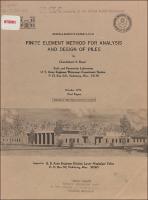Please use this identifier to cite or link to this item:
https://hdl.handle.net/11681/20921| Title: | Finite element method for analysis and design of piles |
| Authors: | United States. Army. Corps of Engineers. Lower Mississippi Valley Division Desai, C. S. (Chandrakant S.), 1936- |
| Keywords: | Finite element method Hydraulic structures Pile foundations Piling Mathematical models Numerical models Soil mechanics |
| Publisher: | Soils and Pavements Laboratory (U.S.) Engineer Research and Development Center (U.S.) |
| Description: | Miscellaneous Paper Abstract: Many hydraulic structures in the Lower Mississippi Valley region are founded on piles. Static bearing capacities of the piles are conventionally calculated from limit equilibrium theories based on various simplifying assumptions such as homogeneous isotropic soils. Stresses and deformations under working conditions are usually estimated from linear theory of elasticity. Since the real problems involve complexities such as nonhomogeneities, nonlinear stress-strain behavior, and interaction effects, the conventional approaches are deficient for computation of progressive settlements, and stresses and for ultimate capacities. The objectives of this study were to formulate a finite element (FE) procedure and to develop computer codes for analysis of single piles. The formulation includes some significant factors that cannot be handled by conventional approaches. The FE procedure is verified by comparing numerical predictions of stresses and settlements with field observations from a large number of pile load tests performed by the Corps of Engineers and other investigators. The FE formulations use an isoparametric quadrilateral element for the two-dimensional soil and pile elements. The interaction behavior is simulated by a special interface element. The FE method is used for piles in both sands and cohesive soils. The primary quantities for comparisons between the numerical and field results have been settlements at butt and tip of piles, distribution of stresses, and loads carried by pile tip and wall friction. Parametric studies were made of length of embedment and size of piles in computation of bearing capadties. Constitutive laws and effects of such factors as confining pressure, density, stress paths, driving stresses, and residual stresses are also considered. These studies were conducted for piles in sandy soils. Preliminary analyses of piles in stiff cohesive soils and parametric studies for such factors as adhesion, effect of stress paths, distribution of strength, and coefficient of lateral earth pressure were initiated. A laboratory test program to study the effect of stress paths on constitutive behavior was also initiated. These investigations were not completed before the termination of the projects but results obtained are summarized briefly. |
| Rights: | Approved for public release; distribution is unlimited. |
| URI: | http://hdl.handle.net/11681/20921 |
| Appears in Collections: | Miscellaneous Paper |
Files in This Item:
| File | Description | Size | Format | |
|---|---|---|---|---|
| MP-S-76-21.pdf | 9.21 MB | Adobe PDF |  View/Open |